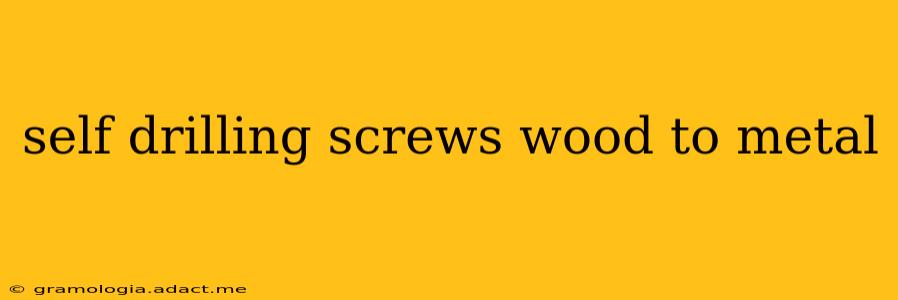Self-drilling screws are a handy fastener, simplifying projects by eliminating the need for pre-drilling. Their unique design allows them to cut through various materials, making them ideal for joining wood to metal—a common task in many DIY and professional projects. However, selecting and using them effectively requires understanding their capabilities and limitations. This guide dives deep into the world of self-drilling screws, focusing on their wood-to-metal applications.
What are Self-Drilling Screws?
Self-drilling screws are characterized by a sharp, pointed tip that initiates the drilling process as the screw is driven in. This eliminates the need for a separate pilot hole, saving time and effort. The screw's cutting point usually has a specially designed cutting edge which can penetrate the material more quickly. Different types of self-drilling screws exist, each suited for different materials and applications. For wood-to-metal applications, understanding the screw's design is crucial for success.
Types of Self-Drilling Screws for Wood to Metal
Several types are suitable for fastening wood to metal, each with its own strengths and weaknesses:
-
Sheet Metal Screws: These screws possess a sharp, pointed tip designed to penetrate thin sheet metal. While they can penetrate wood, they might not be ideal for thicker wooden components as they lack the robust cutting ability for tougher wood materials.
-
Self-Tapping Screws: These often have a more aggressive cutting tip and threads designed for creating their own mating threads in the material. They work well for a wider range of materials but require careful consideration of the wood's density and thickness.
-
Tek Screws: Known for their strength and durability, tek screws are designed for heavy-duty applications, ideal for joining thick wood to metal. Their self-drilling capability makes them a time-saver.
Choosing the right type depends heavily on the thickness and type of both wood and metal involved in your project. Thinner gauges of metal and softer woods require less aggressive screws. Thicker sections of materials call for stronger self-drilling screws with a more robust point and cutting design.
How to Use Self-Drilling Screws for Wood to Metal Joints
While self-drilling screws simplify the process, proper technique ensures a secure and lasting joint.
-
Material Selection: Choose a screw appropriate for the thickness and type of wood and metal involved. Consider the screw's length; the screw should penetrate the metal sufficiently, with a sufficient amount of thread engaging the wood.
-
Pre-drilling (Sometimes Necessary): For exceptionally hard woods or thick metal, pre-drilling a pilot hole might be necessary to prevent the screw from stripping or damaging the material. This is particularly crucial when working with hardwoods. A pilot hole makes penetration easier and prevents material splitting, especially when working with wood.
-
Screw Driving Technique: Use a screwdriver or drill with the correct bit size and apply consistent, even pressure. Avoid excessive force, which could strip the screw head or damage the materials.
-
Appropriate Fastener Placement: Proper placement of the screws is critical for the strength of the joint. Consider the stresses on the joint and strategically position screws to resist those stresses effectively.
What Size Self-Drilling Screw Should I Use?
The optimal size of the self-drilling screw depends on several factors:
-
Thickness of Wood and Metal: Thicker materials require longer screws to achieve adequate penetration and secure fastening.
-
Type of Wood and Metal: Hardwoods and harder metals might require stronger, potentially larger diameter screws.
-
Load Bearing Requirements: Joints subjected to significant stress demand larger and stronger screws to ensure stability and prevent failure.
Consulting screw manufacturer's recommendations and technical specifications provides guidance on screw selection based on specific material combinations and load bearing capacities.
What are the Advantages of Using Self-Drilling Screws?
Self-drilling screws offer several advantages:
-
Speed and Efficiency: Eliminating the need for pre-drilling significantly speeds up the fastening process.
-
Convenience: The all-in-one design simplifies the process, reducing the need for multiple tools.
-
Strength: Many self-drilling screws are designed for high strength and durability.
What are the Disadvantages of Using Self-Drilling Screws?
While convenient, self-drilling screws have some drawbacks:
-
Potential for Material Damage: Incorrect usage can lead to stripped screw holes, cracked wood, or damaged metal.
-
Limited Material Compatibility: Some materials may not be suitable for self-drilling screws.
-
Cost: Self-drilling screws are typically more expensive than standard wood screws.
By carefully considering the type of wood and metal involved, selecting the appropriate screw size, and utilizing the correct driving technique, you can successfully use self-drilling screws to create strong and reliable wood-to-metal joints. Remember to always prioritize safety and use appropriate safety gear when working with power tools.
